Table of Contents
The term “free-swelling” is applied to the behavior of some bituminous coals when heated under specified conditions. Damm defined the swelling of coal as the volume change that takes place when coal is heated. The softened coal can expand, for example due to gases being released on pyrolysis, in the direction away from the heating surface. The degree of swelling can be expressed in numbers of 1 to 9 based on cross-sectional area profiles of the swollen sample, convenient linear units, or as a percentage of the volume of the original coal sample.
The free-swelling test was developed in England and was made a standard method of test by the British Standards Institution under the title of “Crucible Swelling Number”. The method was modified and adopted by the American Society for Testing and Materials as a standard. This modification of test is titled “Free-Swelling Index (FSI)”. Swartzman stated the ASTM specifications of the test were too rigid for most coals. Young cautioned that for weathered coals and some low-volatile coals the ASTM tolerances must be followed.
The free-swelling index is used to estimate the caking properties of coals during combustion on a grate, to differentiate between agglomerating and nonagglomerating coals., and to detect weathered or oxidized coals. The free-swelling index gives supplementary information on the plastic properties of coals. It should not be used to evaluate the expansion properties of coals to be used in coke ovens.
The ASTM method for determining the free-swelling index uses a 1-gram coal sample. The need for a smaller scale test arises when only a limited supply of coal, particularly the macerals for special geological and chemical studies, is available. Therefore it is necessary to modify the ASTM method for testing smaller weight samples. Trials were made with various sample weights of less than 1 gram; 0.3 gram was found to be the minimum sample weight that yields satisfactory results. This Bureau of Mines report gives the results using this modification.
Method of Testing
In the ASTM Standard Method D 720-67, “Test for Free Swelling Index of Coal” (appendix), 1 gram of 60-mesh coal is heated under specified conditions in a 17-ml silica crucible with a ring-handled lid called a regular lid. The coke button is removed from the crucible and is assigned a free-swelling index number by comparing it with a series of standard profiles.
Our modified method for 0.3-gram coal samples uses a 5ml silica crucible with an inverted crucible as a lid, along with a corresponding reduced rate of gas flow to maintain the same heating rate as used in the standard method. Other conditions follow ASTM Test D 720-67.
Thirty coals were tested by both the ASTM and the modified method using regular lids. Four to twelve buttons were made for each coal. Eleven coals were tested in both methods but using inverted crucibles as lids. Five to sixteen buttons were made for each coal using this modification.
The weights and dimensions of the crucibles and lids are as follows:
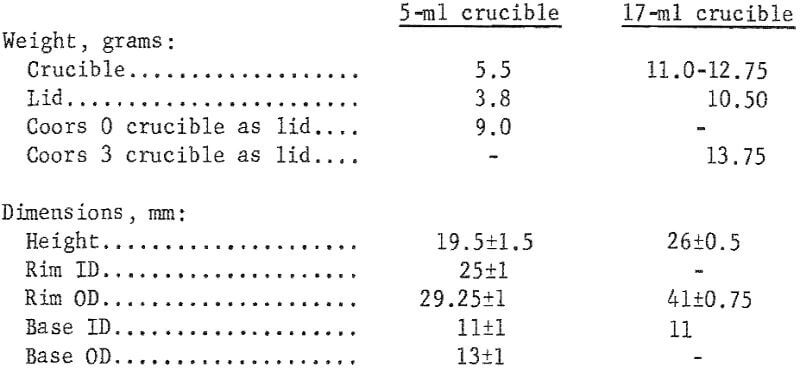
Results
Table 1 presents the results of two series of tests using regular lids and inverted crucibles as lids. Each series uses both standard ASTM procedures and modified procedures. Maximum, minimum, and average areas with their corresponding free-swelling indexes for the buttons made for each coal are tabulated. Standard deviation and relative standard deviation for the average cross-sectional area of the buttons for each coal are given. The relative standard deviation values range from 0.9 to 9.3 percent for the 1-gram samples and from 2.1 to 8.1 percent for the 0.3-gram samples.
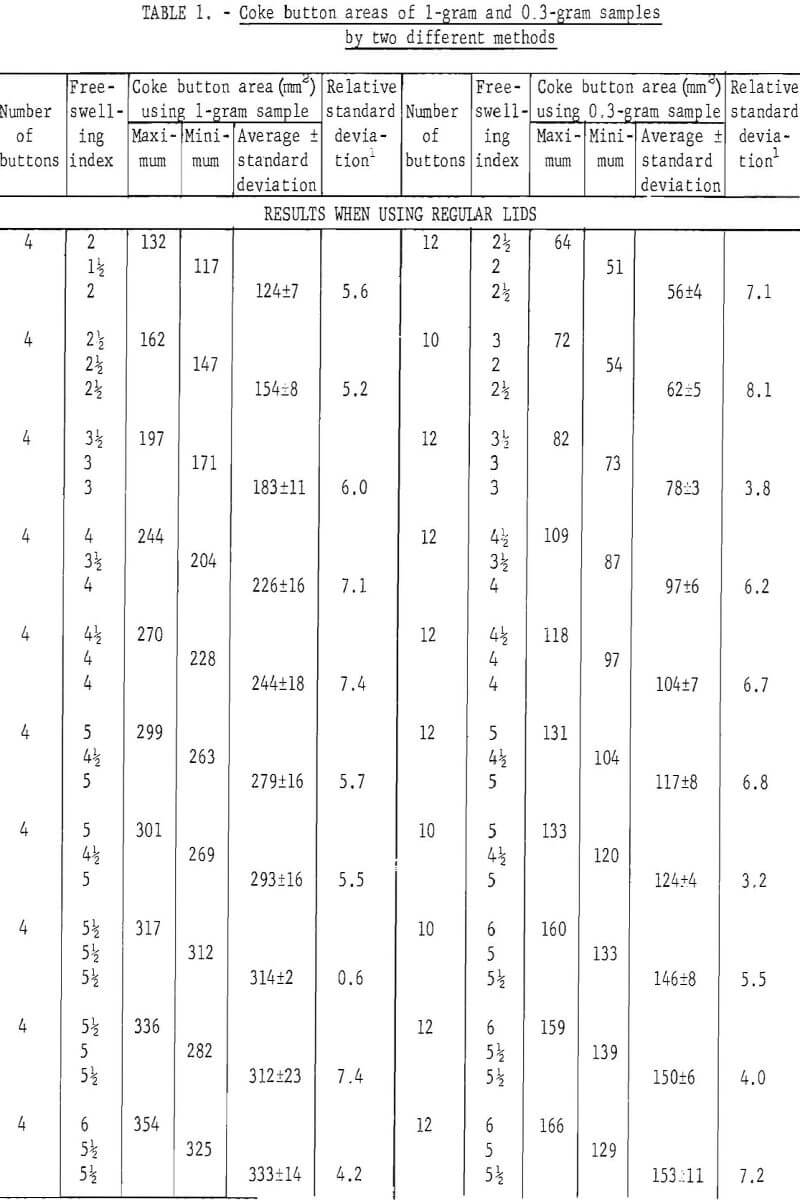
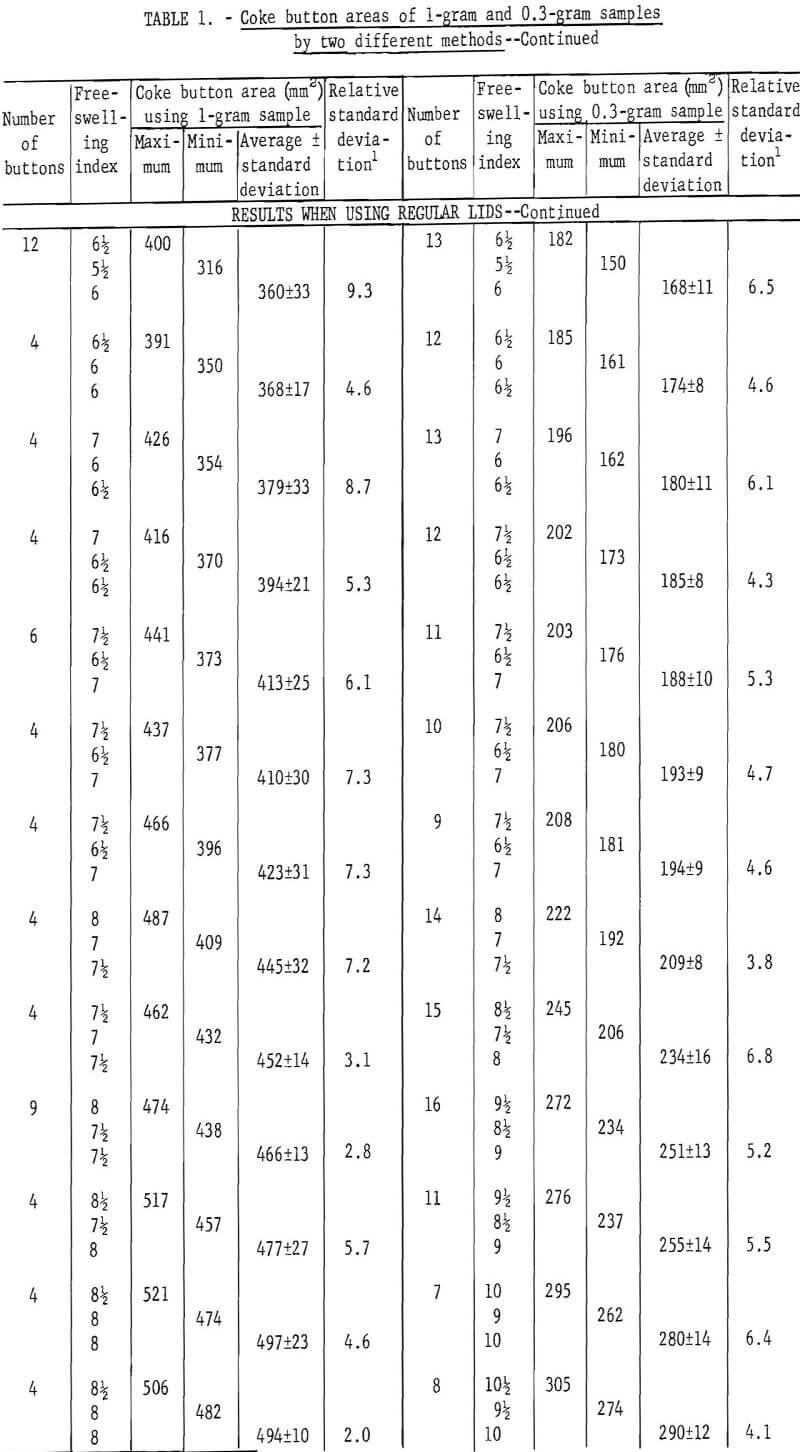
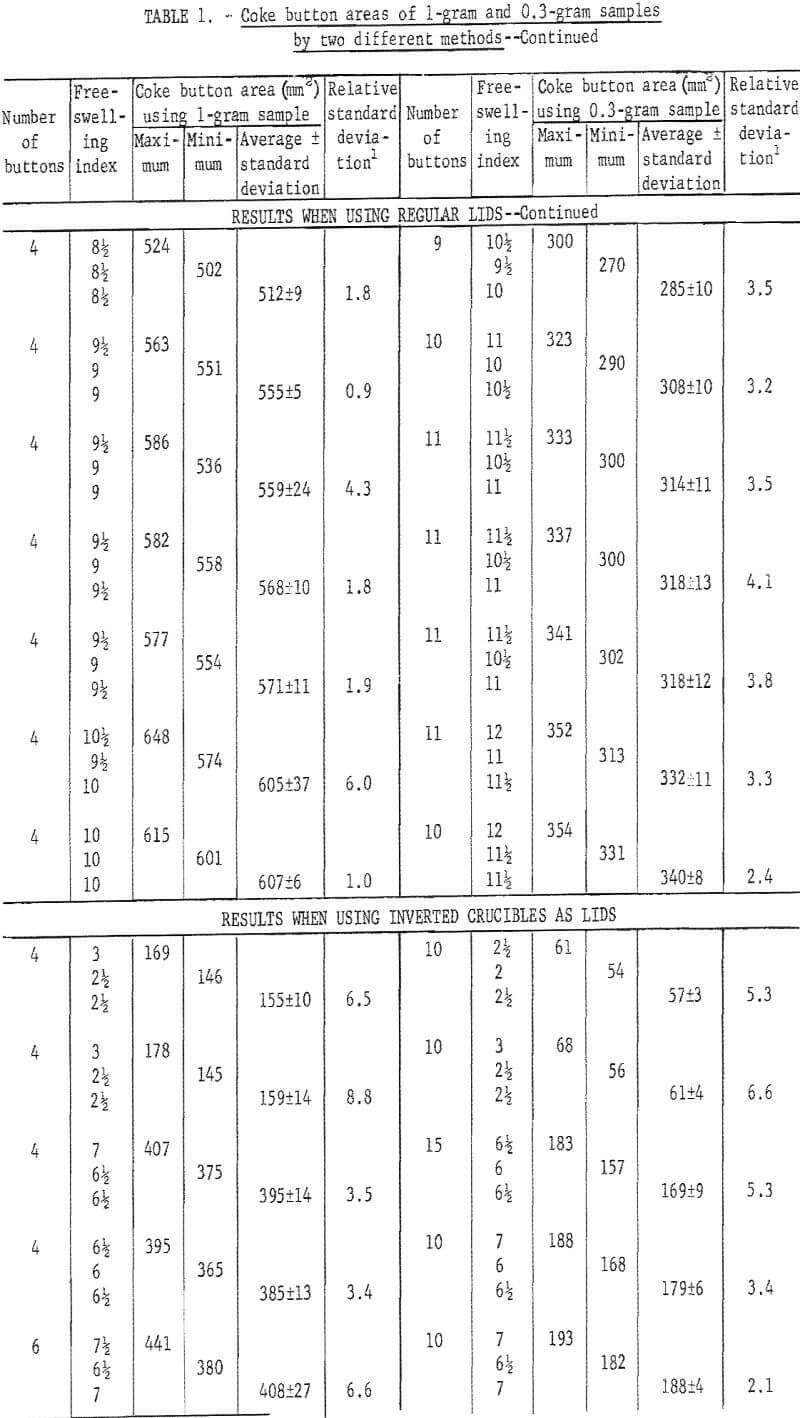
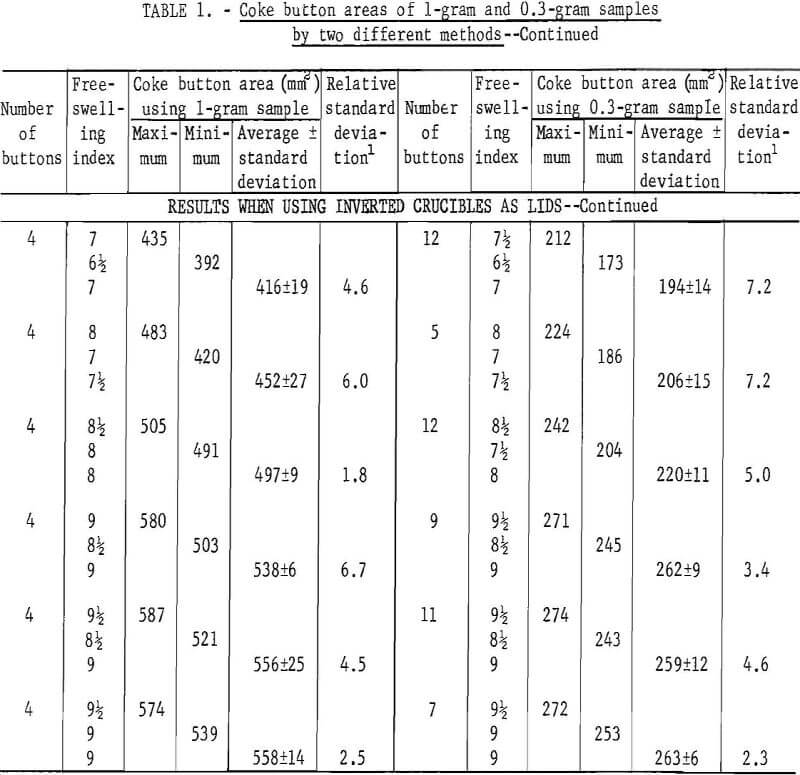
The average coke button area values for 41 coals using 1-gram samples were plotted against the corresponding area values using 0.3-gram samples. Figure 1 presents this plot. Figure 2 presents a plot of 0.3-gram sample profile areas obtained from figure 1 versus swelling index numbers.
Table 2 presents the coke button areas of the standard profiles for each free-swelling index for 1-gram and 0.3-gram samples. The 1-gram area values are from a Bureau publication ; either as given or by extrapolation. The 0.3-gram area values are from figure 2. These values are presented as 0.3-gram profiles (fig. 3).
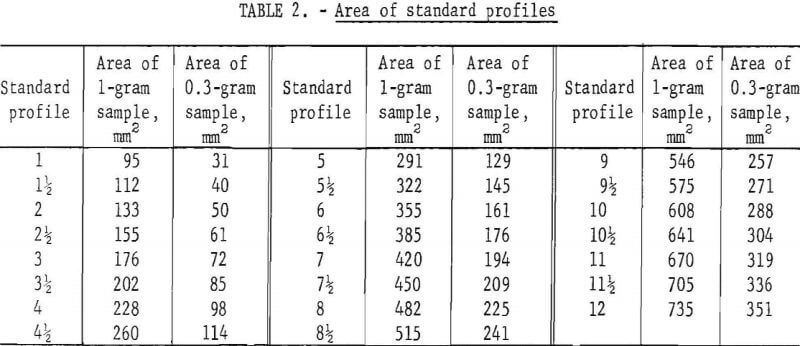
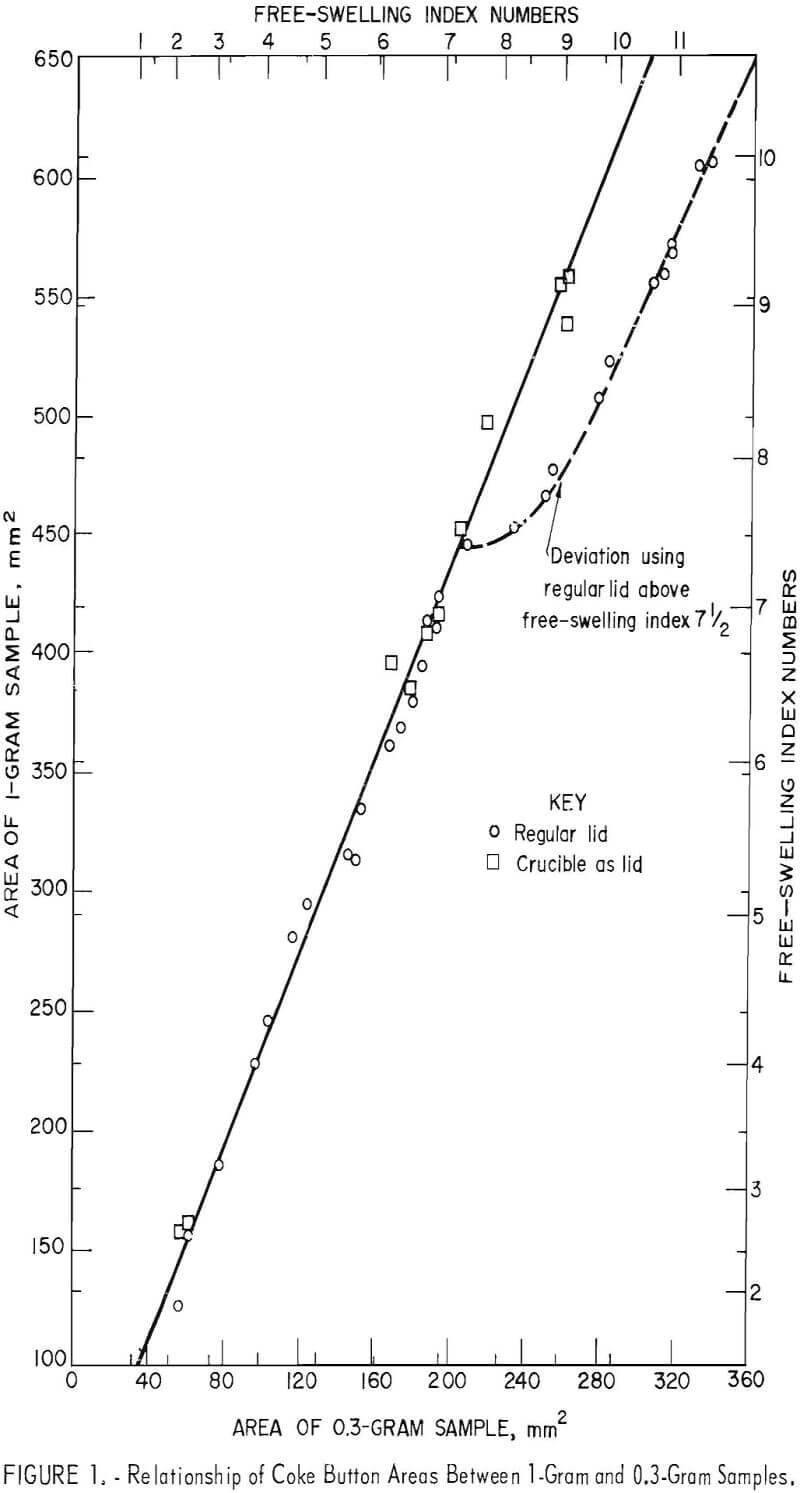
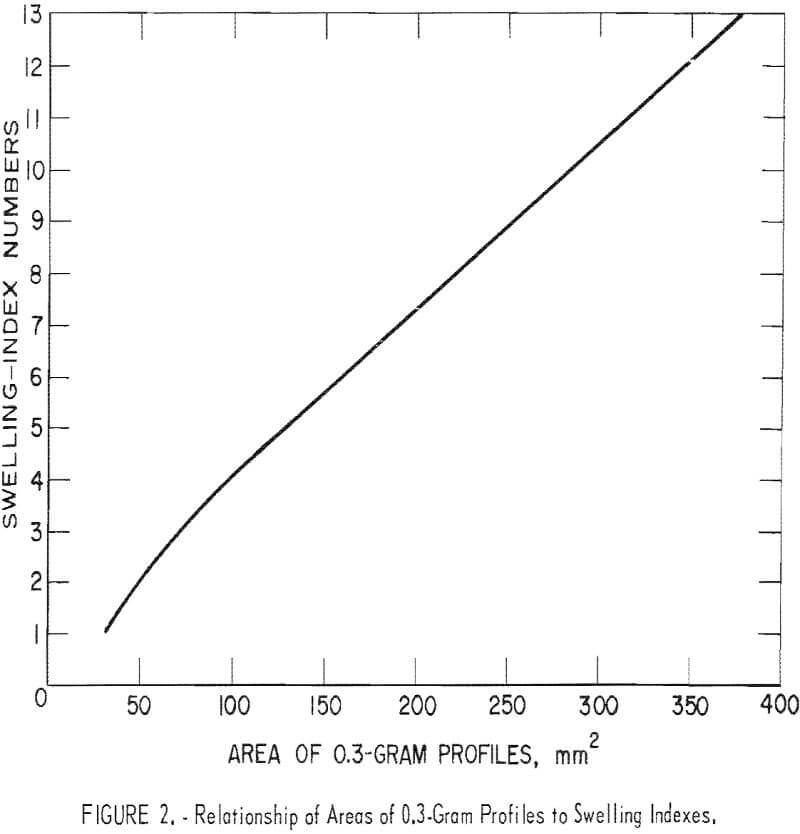
Discussion of Results
Figure 1 shows that a linear relationship of coke button areas between 1-gram and 0.3-gram samples occurs for indexes from 1 to 7 using regular lids.
The linearity fails above 7. The 1-gram and 0.3-gram buttons for indexes above 7 show a flat head (fig. 4), which means that the lids prevent free-swelling. The 0.3-gram button for index 7 just slightly touched the lid; the 1-gram button touched the lid, but its sideward swelling may compensate for a free-swelling effect. That is, the area of this button would equal the area of a button that
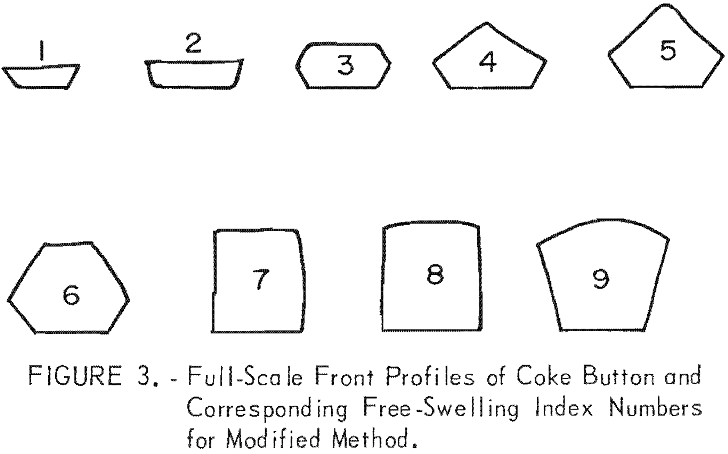
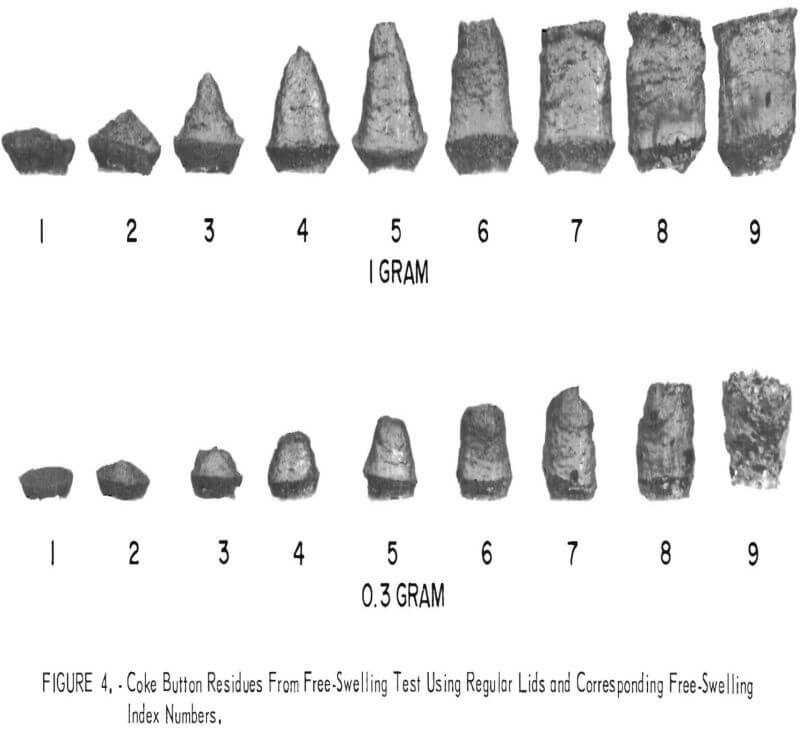
swelled unrestricted. Buttons for indexes 10 to 12 (not shown in fig. 4) also touched the lids and gave flat head profiles just as they did for indexes 8 and 9.
Figure 1 also shows that with an inverted crucible as a lid, the linearity of the curve continues beyond index 7.
Both the 1-gram and 0.3-gram buttons did not touch their lids. Some of these buttons are compared with the buttons using regular lids in figure 5.
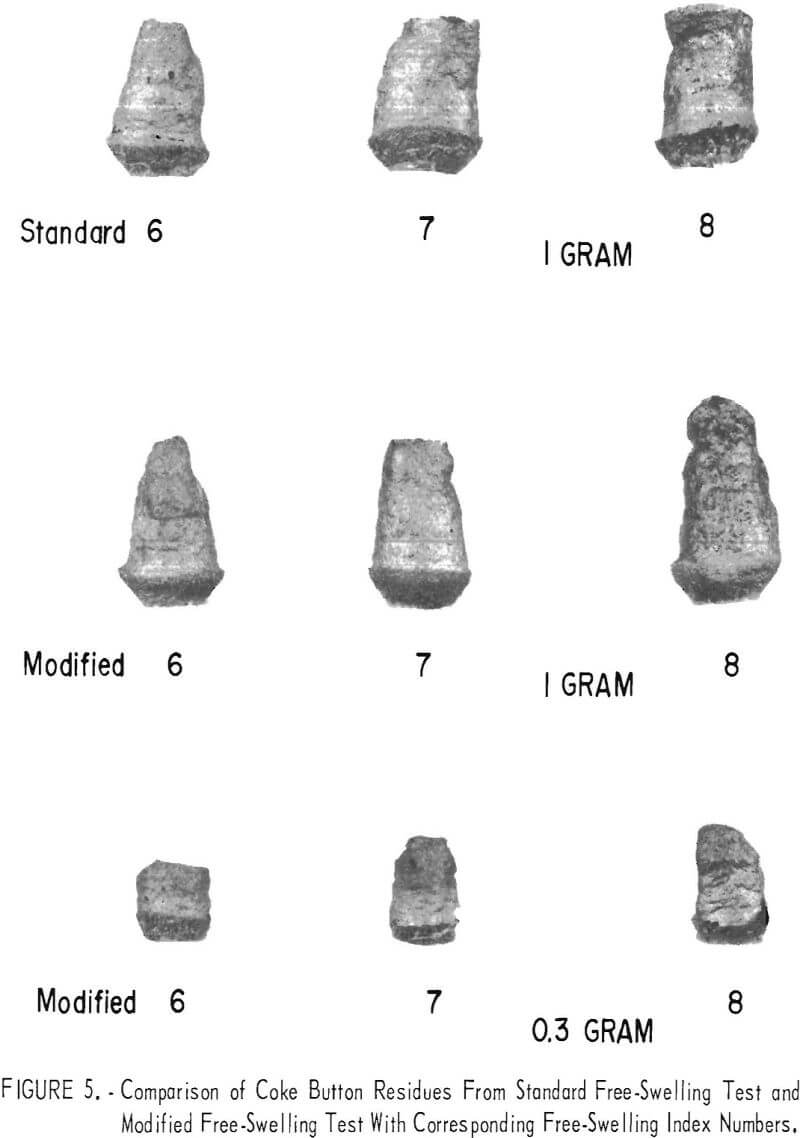
The profiles shown in figure 3 can be used in determining the free swelling index for 0.3-gram samples, by matching the button with the profile closest to its cross-sectional area. The free-swelling index can also be determined by measuring the coke button’s cross-sectional area in square millimeters and by referring to the graph (fig. 2) for the index.
Conclusions
- Three-tenth-gram samples can be used for small-scale free-swelling index tests using ASTM D 720-67 procedures and apparatus with only minor modifications in equipment and procedures. The index can be determined by matching the button with the profile for this purpose.
- The present standard method of test can measure free-swelling properties even at the higher index levels above 7, by simply using an inverted Coors 3 crucible for a lid.
Appendix.-Astm Standard Method of Test for Free-Swelling Index of Coal
Apparatus
This test is made with gas heating. The apparatus consists of the following:
- Crucible, translucent silica, low-form, with silica ring-handle lid, conforming to the following requirements; also an extra pierced lid for use in determining the crucible temperature:
Weight, g…………………………………………………….11.0 to 12.75
External height, mm………………………………………26±0.5
External diameter at top, mm…………………………41±0.75
Internal diameter at base, min, mm………………………11
Capacity (approx.), cm³……………………………………….17 - Sight tube, 25.4 cm high by 3.8 cm in diameter, supported on a ring stand for viewing coke buttons so that the effect of parallax will be eliminated.
- Thermocouple and potentiometer.
- A 500-gram weight.
- Burner assembly. A gas burner with a grid of external diameter 30 to 42 mm, a draft shield, and a triangular crucible support (fig. A-1). The draft shield, conforming to the dimensions shown in figure A-1 is made from asbestos-cement pipe, and at the top it has three slots, 25 mm in depth, in which the wires of the crucible support rest. The draft shield is supported on a ring stand, so that the distance between the base of the crucible and the top of the burner grid can be adjusted by raising or lowering the draft shield. The triangular crucible support is made of three pieces of translucent silica tubing each 63 mm in length, 6 to 6.5 mm in external diameter, and mounted on chromium-nickel wire so that the diameter of the inscribed circle is approximately 32 mm. The twisted ends of the triangle is joined together by a loop of wire to facilitate removal of the hot crucible. The gas burner is placed in the gas line after a flowmeter-water manometer unit.
6. Flowmeter. A capillary flowmeter-water manometer unit is placed in the gas line to serve as a guide to control the rate of gas flow to the burner (fig. A-1). Control is manually made by adjusting the gas value.
Calibration
With the burner assembly arranged as shown in figure A-1, and with an empty crucible in position, light the burner about 15 minutes before making a determination to allow the draft shield to rise to an equilibrium temperature.
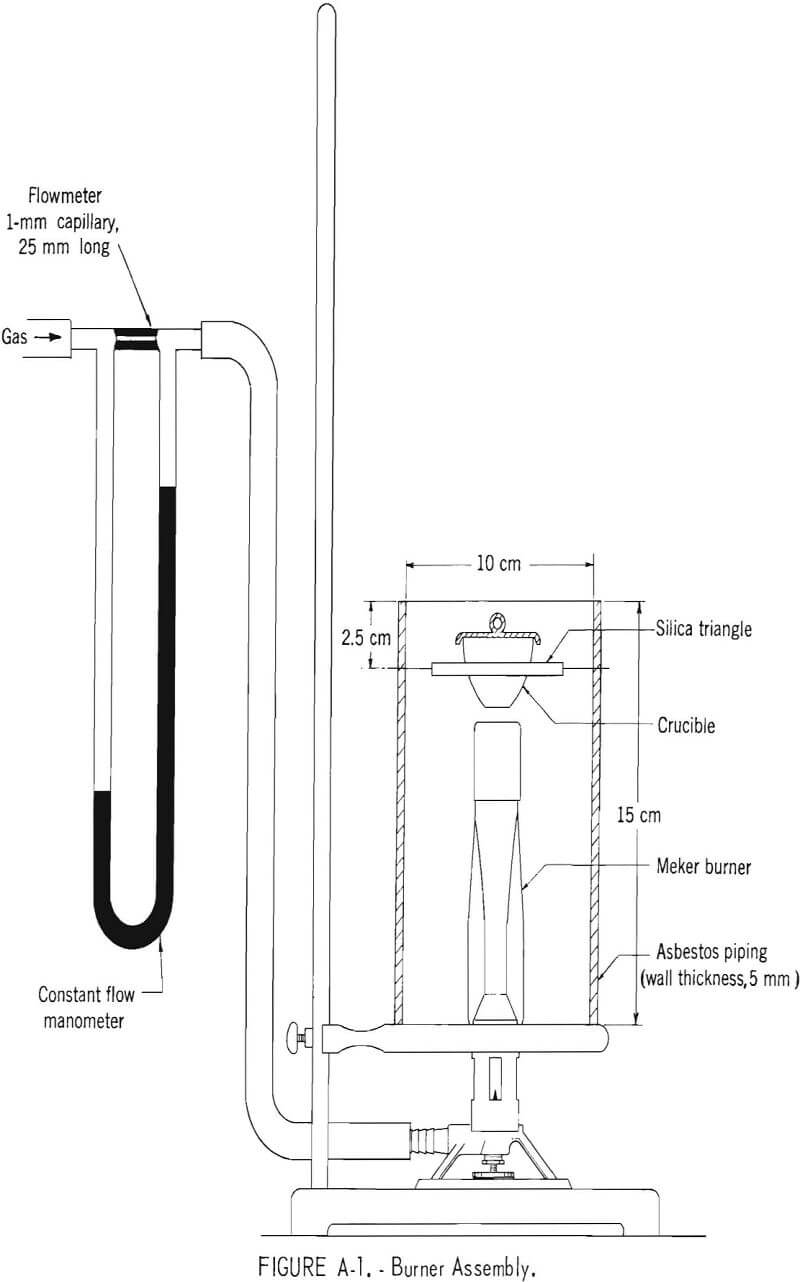
After placing a crucible in position, adjust the flow of gas and the relative positions of the burner and the draft shield so that the temperature of the inner surface of the bottom of the crucible reaches 800°±10° C in 1½ minutes and 820°±5° C in 2½ minutes. Determine the crucible temperature by means of a thermocouple and a potentiometer. Insert the thermocouple through the pierced crucible lid so that the unprotected junction of the thermocouple and a portion of each wire are in contact with the base of the crucible.
Preparation of Sample
The analysis sample of coal is prepared in accordance with ASTM Method D 2013-68, “Method of Preparing Coal Samples for Analysis.”
Procedure
- Weigh 1 gram of the prepared sample into a cold crucible, and level by lightly tapping the crucible 12 times on a solid surface, rotating between taps. Cover the crucible with a lid and place it upright in the silica triangle supported in the draft shield, directly over the gas flame. Heat the covered crucible in the gas flame for the time required for the flame of the burning volatile matter to die out, but in any case not less than 2½ minutes. Remove the coke button and any carbon residue. Make three buttons for each sample of coal tested.
- Measurement of coke button:
a. View each coke button through the sight tube and compare it with the series of standard profiles shown in figure A-2. Place the standard profile with which a button is to be compared exactly in the center of the field of vision as viewed from the top of the tube. Place the button on the profile and rotate it on its axis until, viewed with the eye placed immediately over the top of the tube, the maximum cross-sectional area is obtained. Record the number of the standard profile most nearly matched by the maximum
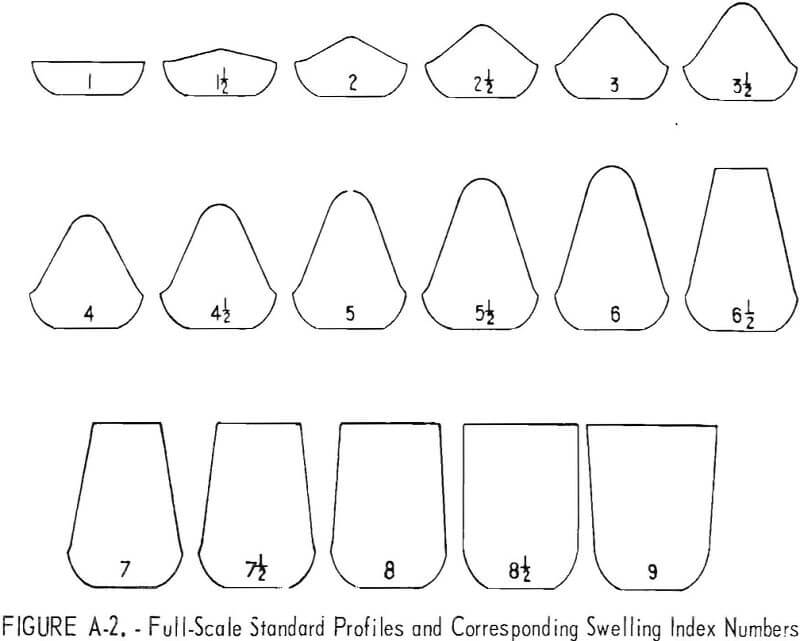
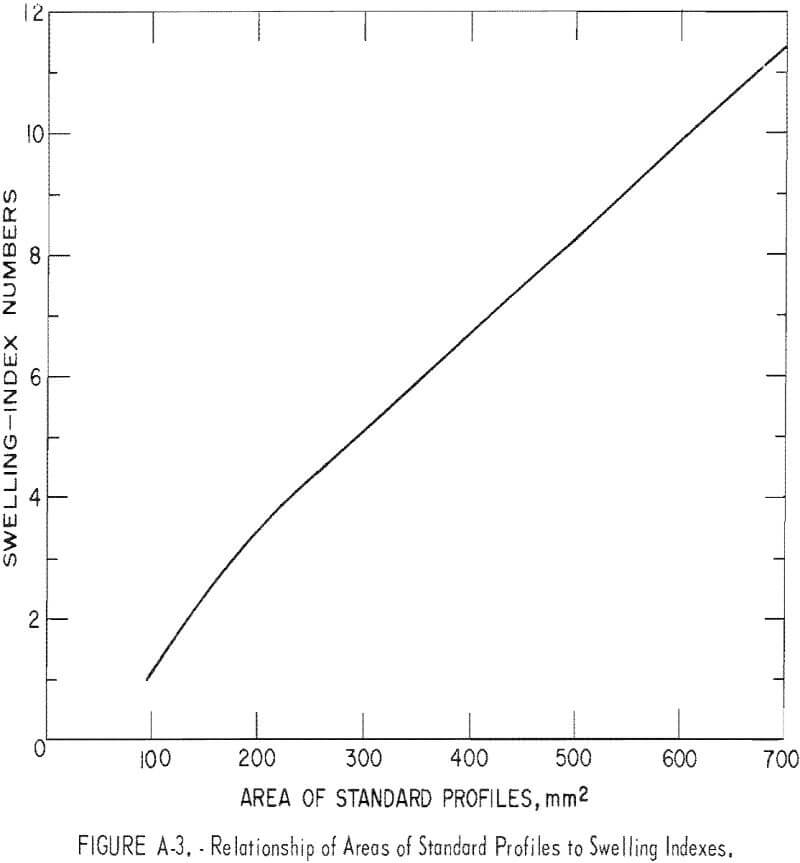
cross-sectional area of the button as the swelling index. If any button deviates by more than 1 unit from the other two buttons, make a new determination.
b. Some coals give buttons that do not conform in shape to the standard profiles. For such coals, measure the maximum cross-sectional areas of the buttons, and determine the index from the relationship of the areas of the standard profiles to swelling indexes as shown in figure A-3. For measuring the cross-sectional areas, mount the buttons on graph paper ruled into square centimeters that are subdivided into square millimeters, and trace the outlines of the buttons on the paper while viewing through the sight tube. The squares inside the outline may be counted, and fractions of squares along the boundary line estimated.
c. If the residue is coherent but non-swollen, place it on a flat surface and carefully place the 500-gram weight on the button. If the button disintegrates, report the swelling index as one-half. If the button supports the weight or merely cracks into two or three hard coherent pieces, report the number as 1.
Report
Report the average swelling index of a series of three buttons expressed to the nearest one-half unit. Report the swelling index as zero if the residue from the test sample is noncoherent.
